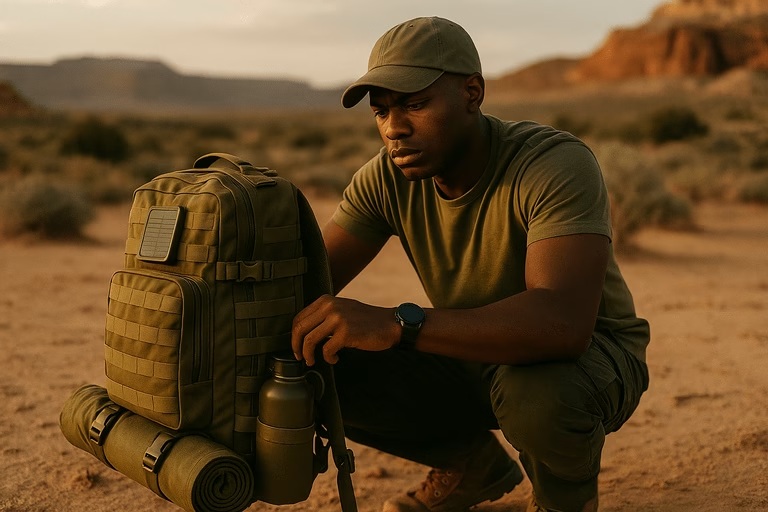Emergencies rarely come with a warning. That’s why owning a survival gear backpack is one of the smartest decisions you can make. Whether you’re hiking in remote areas, preparing for natural disasters, or simply want peace of mind, a well-equipped backpack can mean the difference between panic and survival.
For instance, imagine a sudden storm cuts off electricity for days. With the right gear already packed and ready, you can focus on staying calm and safe instead of scrambling for supplies. In addition, survival gear backpacks aren’t just for preppers—they’re for anyone who values preparedness.
What Should Be Inside a Survival Gear Backpack
A proper survival gear backpack should contain everything you need to stay safe, nourished, and informed for at least 72 hours. Begin with water purification tools, non-perishable food, and a first aid kit. Add a flashlight, extra batteries, and a multi-tool.
Moreover, don’t forget items like a portable stove, emergency blanket, paracord, and weather-appropriate clothing. For communication, include a hand-crank or solar-powered radio. These tools help you stay connected and alert in unpredictable situations. Also, always include copies of IDs, maps, and emergency contacts.

How to Choose the Best Survival Gear Backpack
Selecting the right survival gear backpack depends on your location, environment, and personal needs. Look for a durable material such as ripstop nylon, and ensure the bag is water-resistant. A high-capacity backpack with multiple compartments helps keep your gear organized.
Therefore, test the weight when fully loaded—it should be manageable even when carried for hours. In addition, padded shoulder straps and a chest belt improve comfort and balance. Some advanced models even include hydration systems or built-in solar panels for charging small devices.
Survival Gear Backpack for Urban Environments
Most people assume that survival backpacks are only useful in the wild. However, a survival gear backpack is just as important in cities. Earthquakes, power grid failures, and civil unrest can occur without notice, and having emergency tools on hand becomes crucial.
For urban use, customize your kit with items like N95 masks, gloves, small cash bills, and a compact crowbar. Furthermore, lightweight food, an emergency whistle, and a headlamp with extra batteries will keep you safe during a blackout or evacuation. Having the kit ready saves time when seconds count.

Tips for Keeping Your Backpack Ready
A survival gear backpack is only effective if it’s maintained properly. Set a schedule to check your gear every three to six months. Replace expired food, test your flashlight, and update your emergency contact list. In addition, rotate medications and batteries to avoid failures during critical moments.
Keep your bag in an accessible location—near your front door, under your bed, or in your car trunk. Everyone in your household should know where it is and how to use its contents. Practice mock drills so you’re confident in using every item inside.
Customizing a Survival Gear Backpack for Your Needs
Every person and environment is different, so it’s important to tailor your survival gear backpack to your lifestyle. For instance, if you live in a cold climate, be sure to add hand warmers, thermal blankets, and extra socks. On the other hand, those in hot, dry regions should pack electrolyte tablets and sun protection.
Additionally, consider who will be using the backpack. A family may need extra food, water, and baby supplies. Seniors might need mobility aids or medications. In all cases, compactness and functionality are key. Therefore, test your kit periodically by simulating a real-life scenario.

Best Practices for Carrying a Survival Gear Backpack
Wearing a fully loaded survival gear backpack can be physically demanding if not properly adjusted. Distribute weight evenly, placing heavier items closer to your back and lighter ones farther out. Tighten all straps snugly but not uncomfortably.
Moreover, avoid overpacking. Survival isn’t about luxury—it’s about carrying exactly what you need to endure a difficult situation. For example, don’t carry a full toolbox if a multitool will suffice. In addition, always keep high-priority items—like a flashlight or whistle—in easy-to-reach external pockets.
Quick Recap
Here’s a summary of the most important points covered about the survival gear backpack:
- 🔹 You need a backpack ready for at least 72 hours of survival
- 🔹 Include water purification, food, medical supplies, and tools
- 🔹 Choose a durable, waterproof bag with multiple compartments
- 🔹 Customize contents for urban vs. rural environments
- 🔹 Rotate and refresh gear every 3–6 months
- 🔹 Store the bag in an easy-access location at home or in your car
- 🔹 Tailor it based on personal needs, health conditions, and climate
- 🔹 Use best practices when carrying and distributing weight
- 🔹 Train yourself and your family with mock drills
- 🔹 Keep it simple: avoid overpacking with non-essentials
Final Thoughts: Preparedness Starts with the Right Backpack
Preparedness is no longer a niche concept—it’s a necessity in today’s unpredictable world. Owning a survival gear backpack means you’re ready to protect yourself and your loved ones when systems fail, roads close, or help is delayed. It’s not about living in fear. It’s about having confidence and control when it matters most.
Start building your backpack today. Begin with the essentials and grow from there. Test it, personalize it, and most importantly—keep it ready. Because when disaster strikes, the only thing worse than not having the right tools is knowing you could have been prepared.

